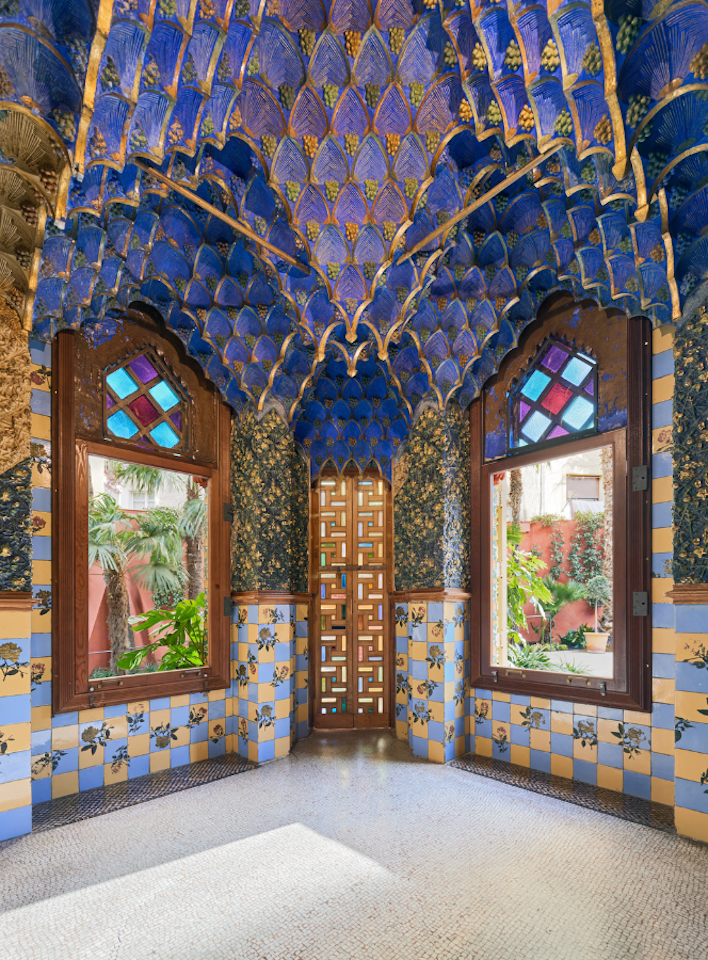Casa Vicens Gaudí is working on the recovery of the original polychromy of its “fumoir”
The smoking room will be partially closed until 31 October so that the recovery work on the original polychromy can be performed
A few months before Gaudí’s first house was opened to the general public in 2017, the colour on the walls and the ceiling of one of its most iconic rooms, the “fumoir”, was found to conceal a different polychromy.
A cream-coloured coat with gilt touches had been applied over Gaudí’s original blue epochal colour. A meticulous stripping process revealed that both the top part of the walls, decorated with hard cardboard tiles, and the surprising plaster muqarnas ceiling, concealed a rich blue polychromy, with different tones of green for the palm leaves and gold for all the embossed work. All this polychromy, applied after Gaudí, has been slowly and gradually removed with surgical precision, with a knife. After a titanic undertaking lasting several months in 2017, a large part of the cream colour had yet to be removed. Restoration work has been conducted in this room since then, the most intense part in January 2019, in the course of which virtually all of the ceiling’s original polychromy was recovered.
The house-museum is now determined to resume the restoration of the hard cardboard walls with a view to showcasing this iconic room in its characteristic blue colour for Gaudí Year 2026 (Centenary of the death of Antoni Gaudí).
The conservation team of this UNESCO World Heritage Site will be working up until 31 October to analyse different techniques and products in order to eliminate the coat of paint applied by the second family that owned the house. The aim is to discover the most effective system and product in order to expedite the restoration.
In the words of its director, Emili Masferrer, “recovering the essence of the fumoir has been one of our goals since we opened in 2017, and the work to be done in this room is very complex, not only on account of its dimensions, but also because the material is very delicate: this is why, to date work has only been conducted on days on which we are closed to the public so as not to interfere with visiting activities. However, for the first time ever, this time the analysis will be performed while the museum is open”.
A singular decoration: hard cardboard tiles
One of the unique features and therefore also one of the main difficulties involved in restoring this room, which has a surface area of just under 10 m², lies in the material used at the top of the walls. We are talking about hard cardboard tiles, a very innovative decorative application conceived by Hermenegildo Miralles (1858-1931), also known as “imitation tiles” because they look like ceramic tiles. This technique was patented in 1892, seven years after Casa Vicens had been built. It is therefore very likely that Gaudí and Miralles worked together to conceive this new type of material and that they chose Casa Vicens to test its strength.
These tiles were made using different layers of paper joined together with a hydraulic press to make them harder and stronger. The drawing, printed using lithography or photography, was applied to the top layer, which was then finished off with a coat of varnish to give it a bright look and also to waterproof it. This new type of tile was conceived to be used to cover murals, ceilings and chair rails. The technique had many advantages, since the materials were very economical and easy to produce, were light and therefore easily transportable and also very simple to install and maintain. For all these reasons, besides the huge number of ornamental motifs they could provide, hard cardboard tiles achieved great success among architects and decorators of the era. For example, they were used in the Hotel Colón in Plaza Catalunya or in the Café Torino of Paseo de Gràcia, neither of which exists today.

Period context of the smoking room
To talk about the smoking room in the Casa Vicens is to talk about the taste for all things Oriental and exotic that was fashionable throughout Europe in the 19th Century, and which was felt in all manifestations of art, from painting to literature, music, furniture and architecture. The fascination westerners had for the Oriental was strongly allied to the Romantic Movement and had its roots in colonial expansion by European powers. In Spain, this expansion was directed towards Africa, and information about the habits customs and attire of its people were circulated via the media, leading to countless engravings and prints of Oriental scenes which helped capture the public’s imagination. Numerous publications and studies also were published connected with this still unknown part of the world.
In this context, a room associated with tobacco consumption appeared in western domestic architecture, complete with decoration demonstrating the nineteenth-century interest and fascination for exoticism and far-away countries. These rooms were usually decorated with Eastern elements, in order to create an atmosphere referring to a romantic idealisation of the East that was based on imagination and fantasy.
The smoking room was incorporated into domestic environments and known in France as a fumoir and here as a fumador, as well as an Arab room, a Turkish room or an Oriental saloon, and became fashionable throughout nineteenth-century Europe in the houses of the wealthy and was closely linked to the habit of smoking.
Although tobacco arrived in Europe soon after the discovery of the American continent, it was not until the nineteenth century that its consumption became more widespread. By this time it was imported from the East, which explains the Oriental connotations. It was during the Industrial Revolution when the product became highly popular, giving rise to its mass production and marketing.
Cigar smoking was an activity associated with exclusivity, luxury and elitism, although the nuisance caused by the smell was a constant concern during the nineteenth century, leading to great attention being paid to the planning of the ventilation of homes. For this reason, a special room was added to the list of domestic spaces, which developed into something more than simply being a place to retire to smoke.
In the context of nineteenth-century domestic architecture it represented an example of the clear division between masculine and feminine spaces, given that it was a space predominantly used by men. The smoking room was configured as a private place for men, where they could amuse themselves, talk about business, read, relax and enjoy tobacco in an atmosphere of comfort and decoration designed for male users, usually inspired by the Eastern world. In Spain, heavily influenced by its Muslim heritage, these rooms were decorated in a style associated with the Arab world.
About Casa Vicens
Casa Vicens is Antoni Gaudí’s first house, built between 1883 and 1885. Declared a UNESCO World Heritage site in 2005, it is his manifest house, where a young Gaudí, barely thirty years old at the time, laid the foundations of what would be his later architecture. Located in the Gràcia neighbourhood of Barcelona, and owned by MoraBanc since 2024, it opened its doors to the public in November 2017, after three years of restoration and rehabilitation that allowed the house to return to its origins. The outstanding rehabilitation carried out by Martínez Lapeña-Torres Arquitectos and DAW Office, has received various accolades and was a finalist in various architecture awards around the world (FAD Architecture Award Finalist 2018, Rehabilitation Prize at the Lledó Architecture Awards 2018, prize winner in the XIV Spanish Biennial of Architecture and Urban Planning 2016-2017, a candidate for the EU Mies Award 2019 and a finalist in the XI BIAU Awards 2019). Casa Vicens has the Biosphere certification for its commitment to sustainable tourism, the Safe Tourism Certified seal awarded by the Institute for Spanish Tourist Quality, and the Safe Travels seal supported by the World Travel and Tourism Council.
Casa Vicens values
The values that move Casa Vicens Gaudí are audacity, excellence and proximity, values that can be identified in the different programmes offered.
